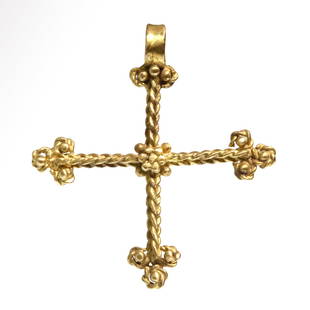
10th C. Byzantine Gold Cloisonne Pendant, Christ
Similar Sale History
Recommended Items




Item Details
Description
Near East, Byzantine Empire, ca. 10th to 12th century CE. A superb nearly 24 karat - 97.6% - gold pendant featuring a cloisonne medallion depicting Christ Pantocrator blessing with his right hand and flanked by letters of the Christogram "ICXC." Surmounted by a double-ribbed suspension loop, the holy figure is rendered in vibrantly hued enamel, featuring shades of scarlet red, emerald green, cobalt blue, light beige, and black. This style of Byzantine pendant is known by the German word Vollschmelz, meaning "full melt" enamel, literally, enamel that covers the entire face. This is a rarer type of pendant than Senkschmelz ("sunk melt") enamel, which depicts enameled figures on a gold background. Size: 1" W x 1.3" H (2.5 cm x 3.3 cm); gold quality: 97.6% (equivalent to over 23 karats); weight: 8.1 grams
The cloisonn? technique in the Byzantine Empire developed during this time to have incredibly thin wires, allowing more precision and detail in depictions, primarily used for religious pendants - as here, with the small letters. The artisan would paste or solder wires (cloisons, from the French word for "partition"), onto the metal body of the pendant. They would then fill in between the wires with a colored enamel paste and fire it at a low temperature. Because enamel often shrinks when fired, the process could be repeated several times. Then the surface of the pendant would be polished until the leading edges of the cloisons appeared, creating fine gold borders in the image.
Byzantine cloisonn? work was so beautiful that it inspired artisans throughout Migration period and medieval Europe. For example, two of the most famous objects from Anglo-Saxon England are cloisonn? enamel and gold: the Alfred Jewel (Ashmolean Museum: AN1836p.135.371) and the Minster Lovell Jewel (Ashmolean Museum: AN1869.20), items so rare in post-Roman Europe that it seems likely based on the craftsmanship that they were made by the same workshop, probably the only one of its kind in England at the time, perhaps run by someone trained in or familiar with the enamel and gold work that was on display in Constantinople (see, for example, Metropolitan Museum: 17.190.678). As today, this religious pendant would have been a valuable, rare, and treasured item for its original owner.
Provenance: private Minneapolis, Minnesota, USA collection, acquired via Artemis Gallery, Louisville, Colorado, USA, May 18th, 2017, lot 42; ex-private New York City, New York, USA collection; previously from a private Munich, Germany collection, collected in the 1970s and 1980s
All items legal to buy/sell under U.S. Statute covering cultural patrimony Code 2600, CHAPTER 14, and are guaranteed to be as described or your money back.
A Certificate of Authenticity will accompany all winning bids.
We ship worldwide to most countries and handle all shipping in-house for your convenience.
#183811
The cloisonn? technique in the Byzantine Empire developed during this time to have incredibly thin wires, allowing more precision and detail in depictions, primarily used for religious pendants - as here, with the small letters. The artisan would paste or solder wires (cloisons, from the French word for "partition"), onto the metal body of the pendant. They would then fill in between the wires with a colored enamel paste and fire it at a low temperature. Because enamel often shrinks when fired, the process could be repeated several times. Then the surface of the pendant would be polished until the leading edges of the cloisons appeared, creating fine gold borders in the image.
Byzantine cloisonn? work was so beautiful that it inspired artisans throughout Migration period and medieval Europe. For example, two of the most famous objects from Anglo-Saxon England are cloisonn? enamel and gold: the Alfred Jewel (Ashmolean Museum: AN1836p.135.371) and the Minster Lovell Jewel (Ashmolean Museum: AN1869.20), items so rare in post-Roman Europe that it seems likely based on the craftsmanship that they were made by the same workshop, probably the only one of its kind in England at the time, perhaps run by someone trained in or familiar with the enamel and gold work that was on display in Constantinople (see, for example, Metropolitan Museum: 17.190.678). As today, this religious pendant would have been a valuable, rare, and treasured item for its original owner.
Provenance: private Minneapolis, Minnesota, USA collection, acquired via Artemis Gallery, Louisville, Colorado, USA, May 18th, 2017, lot 42; ex-private New York City, New York, USA collection; previously from a private Munich, Germany collection, collected in the 1970s and 1980s
All items legal to buy/sell under U.S. Statute covering cultural patrimony Code 2600, CHAPTER 14, and are guaranteed to be as described or your money back.
A Certificate of Authenticity will accompany all winning bids.
We ship worldwide to most countries and handle all shipping in-house for your convenience.
#183811
Condition
A few stable hairline fissures and minor chips to cloisonne, as well as some expected nicks and indentation to gold setting. Otherwise, intact, excellent, and wearable. Impressive preservation of pigments and detail.
Buyer's Premium
- 27.5%
10th C. Byzantine Gold Cloisonne Pendant, Christ
Estimate $4,000 - $6,000
21 bidders are watching this item.
Shipping & Pickup Options
Item located in Louisville, CO, usSee Policy for Shipping
Local Pickup Available
Payment
Accepts seamless payments through LiveAuctioneers

Auction Curated By

PhD. Art History, Director, Fine & Visual Arts
Related Searches
TOP





















































